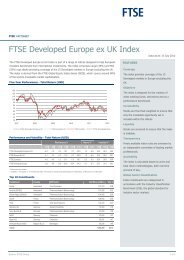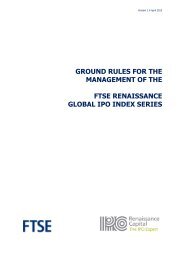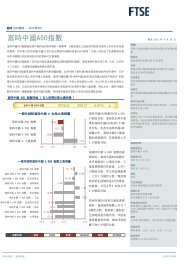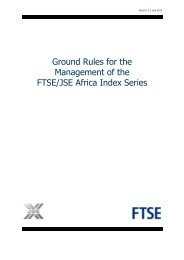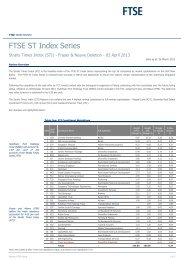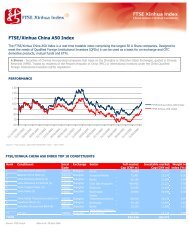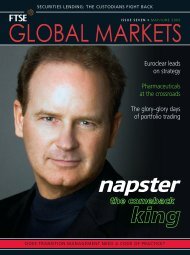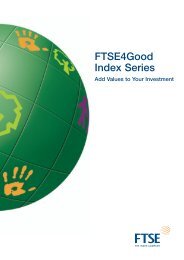QS Investors Diversification Based Investing Whitepaper - FTSE
QS Investors Diversification Based Investing Whitepaper - FTSE
QS Investors Diversification Based Investing Whitepaper - FTSE
You also want an ePaper? Increase the reach of your titles
YUMPU automatically turns print PDFs into web optimized ePapers that Google loves.
4 | Risk exposures<br />
Active risk exposures<br />
Over the last 10 calendar years, on average almost 90% of<br />
the active risk exposures for the <strong>FTSE</strong> DBI Index series came<br />
from country, industry and currency as illustrated in Figure 13<br />
which illustrates the active risk exposure of the <strong>FTSE</strong> DBI<br />
Developed Index compared to the <strong>FTSE</strong> Developed Index.<br />
As DBI specifically focuses on developing alternative weights<br />
Figure 13: <strong>FTSE</strong> DBI Developed Index active risk exposures over time<br />
29/12/2000 31/12/2001 31/12/2002 31/12/2003 31/12/2004 30/12/2005 29/12/2006 31/12/2007 31/12/2008 31/12/2009<br />
Specific % 12.1% 8.8% 8.0% 6.3% 4.2% 5.3% 8.6% 8.0% 11.3% 5.1%<br />
Common % 87.9% 91.2% 92.0% 93.7% 95.8% 94.7% 91.4% 92.0% 88.7% 94.9%<br />
Style % 19.0% 11.7% 18.0% 6.3% 3.6% 3.1% 2.3% 5.5% 14.3% 13.6%<br />
Size % 3.7% 5.5% 4.8% 3.2% 2.2% 1.2% 1.3% 1.9% 0.4% 0.7%<br />
Value % 0.5% 0.0% 0.4% 0.7% 0.1% 0.0% 0.2% 0.2% 0.9% 0.9%<br />
Country % 25.1% 35.1% 39.3% 49.8% 45.6% 54.7% 56.8% 60.7% 62.1% 58.4%<br />
Industry % 12.3% 7.2% 3.1% 3.4% 1.8% 3.4% 3.1% 1.5% 2.7% 3.1%<br />
Currency % 19.6% 32.1% 17.1% 47.7% 44.4% 36.4% 37.0% 27.8% 24.8% 36.4%<br />
Covar 11.9% 5.2% 14.6% -13.4% 0.4% -3.0% -7.7% -3.4% -15.2% -16.6%<br />
SOURCE: Axioma, <strong>QS</strong> <strong>Investors</strong> LLC<br />
5 | Summary<br />
Summary<br />
<strong>Diversification</strong> <strong>Based</strong> <strong>Investing</strong> (DBI) is an international or<br />
global approach to gaining exposure to equity markets that<br />
provides broad exposure and, over the long-term, seeks<br />
higher returns and higher risk-adjusted returns than its<br />
benchmark with less exposure to down markets.<br />
The DBI investment process is designed to capture the<br />
benefits of a higher level of diversification by taking into<br />
account the primary drivers of global equity returns:<br />
geography and industry. <strong>Diversification</strong> is maintained by<br />
taking in to account changing correlations in the countries<br />
and industries thereby reflecting changes in how investors<br />
think of the world and what parts have higher or lower<br />
interdependencies. By diversifying across risk themes or<br />
“clusters” of risk in the market, the more diversified<br />
exposure to the risk premium in these risk themes has on<br />
average led to higher absolute and risk adjusted returns.<br />
<strong>FTSE</strong> DBI Page 14<br />
at the country and industry level, it is not surprising that this<br />
is where the majority of active risk is generated. This is in<br />
contrast to some other alternative weighting approaches<br />
such as fundamental indexing that can generate significant<br />
small cap and value biases.<br />
Owing to its differentiated top down investment approach,<br />
DBI has generated excess return that has been uncorrelated<br />
to both their capitalization weighted benchmarks and some<br />
alternative weighted equity index strategies such as<br />
fundamental indexing. The DBI investment approach has<br />
also led to positive excess return in both rising and falling<br />
equity markets and has captured more than 100% of<br />
returns in up markets and less than 100% of returns in<br />
down markets. The primary drivers of DBI’s active risk<br />
exposures are from active country, currency and industry<br />
positions. The Developed Index strategy has exhibited no<br />
persistent size or style bias relative to its benchmark and only<br />
modest bias at any given time so is a good complement to<br />
both market capitalization weighted indices and alternatively<br />
weighted stock selection indices such as fundamental<br />
weighted indices.



